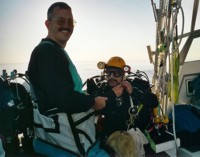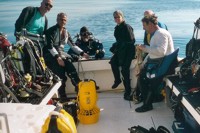Even though NOAA’s offshore forecast was marginal, the Independence II headed out to the Bidevind for an overnight charter. The ship was a Norwegian freighter on her way from Cape Town with a load of manganese ore. She was sunk by U-752 in 1942. Now the wreck lies in 190′ of water west of the Texas Tower. Given the distance from shore, and the proximity to the popular Texas Tower, this wreck is not hit frequently. We reaped the benefits of that neglect.
On the way out to the wreck we found the NOAA’s 5 foot rollers which unexpectedly died down a bit as we got further out. We arrived at the site around 8:00 am. Bill and Terry quickly had us tied in. The surface vis looked good with a medium current pushing the equipment lines at the surface. The divers started gearing up and rolling in.
I was diving with two Trimix students on their first mix dive. We reviewed our plan, and discussed some signals, discussed the decompression, then geared up for the dive. With the entire day before us, there is no rushing to get into the water. We dropped in and did our bubble checks on the line, then descended down to the wreck. Below 30 ft the current dropped off completely, and we just dropped down past other divers on their ascent.
When we arrived at the end of the line, the students found out why people dive these deep wrecks! The visibility was 70ft with enough light to see clearly. The plan was to tie off a reel and head out over the wreck, but with the clear water and light, we could easily navigate, and the strobe on the line could be clearly seen from either side of the wreck. We were tied in at a high point of 160′, and there was a mild current. We dropped down a few feet in the lee and started off on a sight seeing tour.
Below the line were the remains of two small boilers. Since speed is not as important to a freighter as it was to passenger vessels, these may have been the ships main boilers, but I could not make out an engine. We followed the prop shaft back toward the stern. Inflatable Water Slide We moved slowly along, looking here and there at the debris below us. Observing the lobster, eel pouts, and schools of ling cod. It was a shame that our planned depth was only 170, as it was tempting to drop down lower. It was soon time to turn around and head back. In the clear water, we soon saw the strobe on the line and started our ascent. The current picked up again at 30 ft, and it was a bit stronger now. Captain Dan headed down past us as we were finishing up our deco.
When we got back on the boat for the debrief, my first question was “did you notice any narcosis?” None. Clear water and a clear head. It does not get much better. We all discussed what a great dive it was, and wondered why no one comes to this wreck. With the dearth of divers, the wreck was covered with lobster. After tying in, Bill and Terry had put the remaining part of their dive to good use, and were now banding their catch. Captain Dan found a port hole, but said it was to difficult to get to. (My guess is that after you have a few, you think twice about the effort before perusing another.) Dan and I discussed the boilers. He also thought them to be small for the main engine.
Many of the passengers were now catching some sleep before heading in for the second dive. The wind had picked up and the forecast was for a front to come through at night. The decision was made to do one more dive, then head in. We geared up for the second dive and dropped in. The current on the surface had picked up, so we pulled hand over hand until we dropped below it. Bubble checks again, and we dropped down to the wreck.
With the sun lower in the sky it was noticeably darker on the wreck. The vis was still good, and the strobe was even more prominent. I stopped briefly to grab a lobster just forward of the line, then we headed out toward the bow. The current on the bottom was gone, so we made good time swimming over the wreck. Below the hatch covers for the cargo holds were clear, and the bow loomed up before us. Again schools of ling were hiding here and there with huge eel pouts everywhere. Of course, no NJ wreck would be complete without the omnipresent cunners. We stopped at the bow briefly then turned back to the line. The ascent and deco were uneventful save for the current above 30ft. On the surface Capt Dan was grilling up scallops, lobster, and assorted stakes and sausage. A hot meal was just the ticket for cold divers.
Bill and I had planned to splash together and pull the hook, but my second dive was delayed and I would not have enough surface interval. Bill went in with a request for a few minutes of hunting prior to the pull. He would get in a nice twilight dive and grabbed a few more lobsters as we prepared the boat for the trip back. Overhead the sky was showing signs of change in weather ahead. It was time to get going.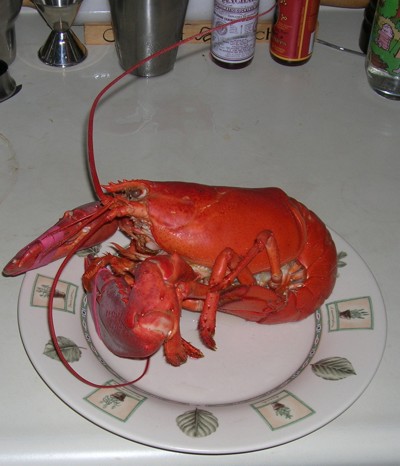
The sun was setting and the strobes we put on the ball were now clearly visible. On occasional we could see Bills light panning around as he hung on the line. While these lights are to attract our attention, they also attracted a pair of curious dolphins. We saw them checking out the strobes on the surface, and could only imagine Bill’s reaction if they stopped by to check him out. When Bill got back on board he confirmed our suspicions, they scared the hell out of him. That is until he figured out they were dolphins.
On the ride back we were treated to a following sea which made for a comfortable ride. Most of the group got in a few hours of sleep. A nice end the a great day.


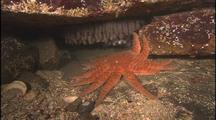
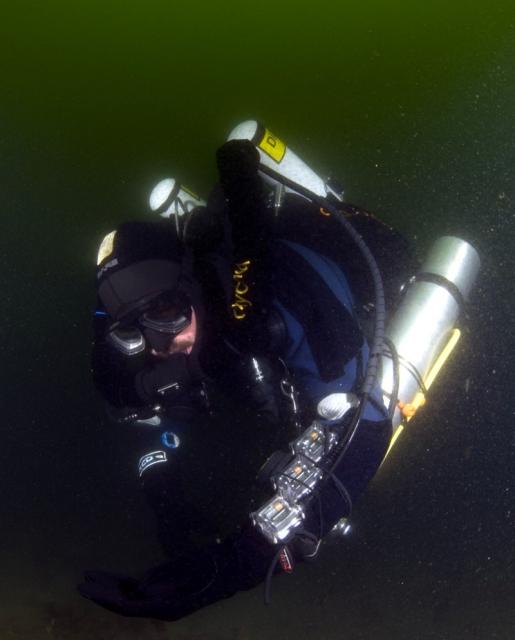
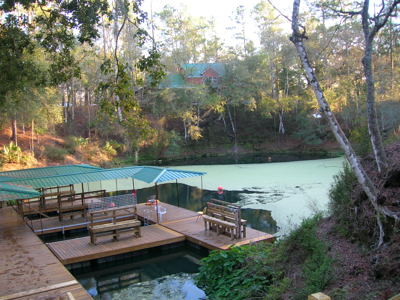 We were up at six and out the door to 40 Fathoms Grotto. It’s recently been taken over by a commercial diving training agency, and is also a NAUI training facility. There have been a lot of changes including a new Mixing station and classrooms. We unloaded, went over the dive plan, reviewed gear configurations, and then jumped in the water for Laughrey to have a look at our abilities. We demonstrated skills, Laughrey would have me demonstrate them to Chris, then he would do them fo me. (At this point, I have to admit that I’ve been CCR, save for Open Water classes. This was my first time in doubles in two years.) Dive one went off without a hitch. We debriefed, and we were off to the classroom.
We were up at six and out the door to 40 Fathoms Grotto. It’s recently been taken over by a commercial diving training agency, and is also a NAUI training facility. There have been a lot of changes including a new Mixing station and classrooms. We unloaded, went over the dive plan, reviewed gear configurations, and then jumped in the water for Laughrey to have a look at our abilities. We demonstrated skills, Laughrey would have me demonstrate them to Chris, then he would do them fo me. (At this point, I have to admit that I’ve been CCR, save for Open Water classes. This was my first time in doubles in two years.) Dive one went off without a hitch. We debriefed, and we were off to the classroom.